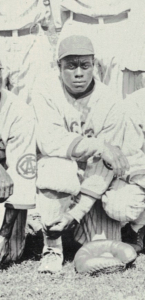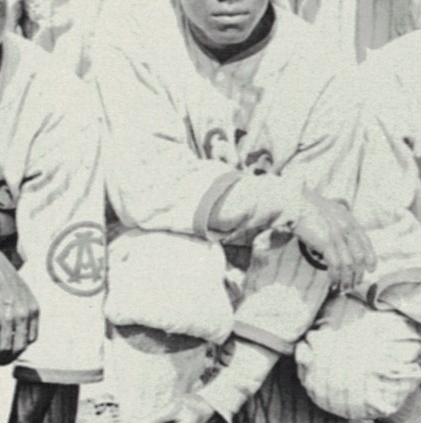George Dixon
 George Dixon, called Tubby most likely due to his stoutness, was a talented catcher who played for 15 years in segregated professional baseball. Most notably, he played with Rube Foster’s Chicago American Giants during the 1920 season, the initial foray in organized Negro League baseball. That iteration of the NNL later folded, but after the second Negro National League reemerged in 1933, Dixon again showed up on the Cleveland Giants’ roster.
George Dixon, called Tubby most likely due to his stoutness, was a talented catcher who played for 15 years in segregated professional baseball. Most notably, he played with Rube Foster’s Chicago American Giants during the 1920 season, the initial foray in organized Negro League baseball. That iteration of the NNL later folded, but after the second Negro National League reemerged in 1933, Dixon again showed up on the Cleveland Giants’ roster.
George Dixon was born on January 4, 1896, in Greenwood, South Carolina, to Chester and Carrie Dixon.1 Chester was a blacksmith by trade, and evidently a successful one as he owned their home. George had a sister, Sarah, two years his senior. Dixon’s 1917 military draft registration card notes that he was “short” with a medium build, that he was unmarried, and that his sole dependent at the time was his unnamed mother. Although little is clear about Dixon’s early life, the Seamheads.com Negro League database notes that he attended Brewer College in Greenwood.2 While such a postsecondary institution has never existed, it is likely that Dixon did attend the Brewer Normal School in his hometown. That school was founded by the American Baptist Association in 1872 “as a school for newly emancipated African Americans.”3 At the time, the school had male and female dormitories and was managed by the Board of Missions of the Congregational Church.4 As the student population was almost exclusively African American, it is reasonable to assume that Dixon was educated there, a Black student in a racially divided community.
Starting with a seven-game stint on the Royal Poinciana Hotel team in Palm Beach, Florida, during the 1916-1917 winter season, Dixon joined the Chicago American Giants on a full-time basis in 1917. A right-handed thrower but left-handed batter with an obvious mind for baseball, he proved to be a natural catcher. In one of his early games in 1917, Dixon caught Dick “Cannonball” Redding’s 16-strikeout effort against the Roseland Eclipse.5 Later, against the rival ABCs, he contributed one of only three American Giants hits off Indianapolis pitcher William “Dizzy” Dismukes in a 3-1 victory. He added the sole Chicago error as well, but he handled pitcher Tom Johnson well enough that the ABCs scratched out only five hits.6 Sharing starting responsibilities with Bruce Petway, Dixon provided valuable contributions in a series of wins over the New York Cubans.7 Dixon closed out the 1917 season with two hits in a 9-3 American Giants win over a collection of White major-league players.8
Negro League historian James Riley summarized Dixon’s introduction to big-time baseball, writing that “Dixon was considered ‘a real find’ when he arrived with the Chicago American Giants in 1917 along with Rudy Tyree as half of a much-heralded ‘Pony battery.’ Initially the young left-handed hitting backstop started strong but he leveled-off and finished with a .253 batting average. …”9
Dixon returned to Palm Beach and the Royal Poinciana Hotel for the winter season, and then headed north to Chicago for the 1918 campaign. In a late May game against Jose Junco and the Cuban Stars, he had a team-high three hits and paced Chicago to a 7-6 win at Schorling Park.10 In July he helped Chicago to another win over Cristobal Torriente and his Cuban squad.11 Dixon had emerged as a powerful hitter, with a fine throwing arm and innate leadership ability, but whose one notable deficiency was his lack of running speed. He was not among the American Giants called up for military service in World War I, and he continued to play for the American Giants until 1922. His 1920 season, in particular, contributed to Chicago’s inaugural championship, and his .324 batting average and .854 OPS were the best in his Negro National League tenure. His 34 runs batted in also proved to be a career high and placed him third on the team behind Torriente and Bingo DeMoss.
Dixon was involved in some memorable games along the way. In June 1921 he and Jim Brown were the catchers for Chicago pitchers Tom Johnson and Tom Williams in a wild game in Indianapolis, one in which Dixon’s powerful bat was critical. Trailing the ABCs 10-0 after three innings, the American Giants scored nine runs in the eighth inning to put the game back within reach. Indianapolis followed that up with eight more tallies in the bottom of the inning, making the score 18-9, but Chicago added nine in the top of the ninth to knot the game. “The American Giants staged a sixteen-run rally off eleven bunts, six successive squeeze plays, and Dixon and Tonchetti’s (Torriente’s) home runs with the bases full, and held the ABCs to an 18 to 18 tie,” the Chicago Tribune reported.12 In October the American Giants “won the eastern colored baseball championship” by defeating the Bacharach Giants, 5-4.13
In 1922 the 26-year-old appeared in 28 games for the American Giants, batting .250 with two home runs in 28 games. The team used Jim Brown as the primary catcher, and Chicago posted a 37-24-1 record in winning the Negro National League. Overall, the American Giants won 45 games against a slate of opponents that went beyond league members. Dixon teamed with Oscar Charleston and player-manager Dizzy Dismukes on the 1923 Indianapolis ABCs. He performed well, hitting .281 in 61 league games, but played most of the next year, 1924, for the Birmingham Black Barons.14 Back with the American Giants for some exhibitions in October, the 28-year-old finished his last genuinely productive season with a .278 batting average in 54 games.
Dixon returned to the American Giants for 1925, but as historian James Riley chronicles, “Rube Foster did some housecleaning and unconditionally released many veteran players. Dixon was dispatched to the Indianapolis ABCs along with Bingo DeMoss to balance the league, and hit .258 in 1926, his last in Indianapolis.”15 Dixon spent 1926 playing for the Indianapolis ABCs, but that team folded at the end of the season. Riley, in his biographical magnum opus, states that Dixon also played for the Cleveland Elites in 1926. Authoritative databases at Seamheads.com and Baseball-reference.com show only that Dixon played the entire year in Indiana, but it is possible that Dixon caught on with the Elites late in the season. The Elites were a one-year team, becoming the Hornets for 1927, and may have had roster fluidity that was neither captured nor archived. Regardless, Dixon did spend the next season in Cleveland with the Hornets (1927), and the Tigers (1928). After a break, Dixon returned to the Cleveland Cubs in 1931, and played his final big-league game for the 4-24 Cleveland Red Sox in 1934. He was relegated to backup catching responsibilities for those years, and by age 38 he was out of professional baseball entirely.
In a sad but not uncommon (for the time), item, the Chicago Defender on August 17, 1940, reported that “George Dixon, former catcher of the Chicago American Giants … died August 4 in the (Cleveland) city hospital. According to Sport Calhoun who knew Dixon well, the body [was] unclaimed.”16 Per Dixon’s death certificate, he had died due to complications from liver cancer.17
From his birth in 1896 to his passing at age 44, George Dixon’s life was brief and, as of the twenty-first century, relatively anonymous beyond his time in professional baseball. He clearly had a passion for the sport and an uncommon set of skills in most phases of the game, and he played in both versions of the Negro National League alongside and against some of the greatest ever to take the field.
Sources
Statistical data is taken from the website www.seamheads.com, unless otherwise noted.
Notes
1 United States military registration card, dated June 5, 1917, and witnessed by Marcella Reed.
2 George Dixon, George Dixon – Seamheads Negro Leagues Database. Accessed: June 8, 2021.
3 The Brewer School, online: History of our School – Our School – Brewer Middle School (gwd50.org). Accessed June 8, 2021.
4 “Brewer Normal Dormitory Burned on Monday Night,” Greenwood (South Carolina) Evening Index, January 16, 1913: 5.
5 “Army Man Drills Fosters; Blank Roseland, 4 to 0,” Chicago Tribune, May 7, 1917: 20.
6 “Foster’s Men Down Hoosier Team, 3 to 1, and Even Up Series,” Chicago Tribune, June 12, 1917: 11.
7 “American Giants Trim Cubans by Hard Hitting,” Chicago Tribune, August 16, 1917: 11; “Giants Beat Cubans Twice,” Chicago Tribune, August 26, 1917: 16.
8 “Fosters Defeat All Stars, 9 to 3,” Chicago Tribune, October 22, 1917: 15.
9 James Riley, “George Dixon,” in The Biographical Encyclopedia of the Negro Baseball Leagues (New York: Carroll & Graf, 2002), 268. www.seamheads.com lists Dixon’s batting average for 1917 as .248, not the .253 that Riley cites.
10 “Fosters Divide Holiday Games with Islanders,” Chicago Tribune, May 31, 1918: 13.
11 “Fosters Beat Cuban Nine, 8-4,” Chicago Tribune, July 5, 1918: 9.
12 “American Giants in Tie,” Chicago Tribune, June 29, 1921: 19.
13 “American Giants Win Ball Title,” Chicago Tribune, October 24, 1921: 18.
14 “Black Barons Drop Opening Battle to Cleveland Outfit,” Birmingham News, August 17, 1924: 66.
15 Riley, 268.
16 “Catcher Dixon Dies; Body Is Unclaimed,” Chicago Defender, August 17, 1940: 24.
17 Certificate of Death: George Dixon. State of Ohio, Department of Health, file number 49044, dated August 28, 1940.
Full Name
George Dixon
Born
January 4, 1896 at Greenwood, SC (USA)
Died
August 4, 1940 at Cleveland, OH (USA)
If you can help us improve this player’s biography, contact us.


